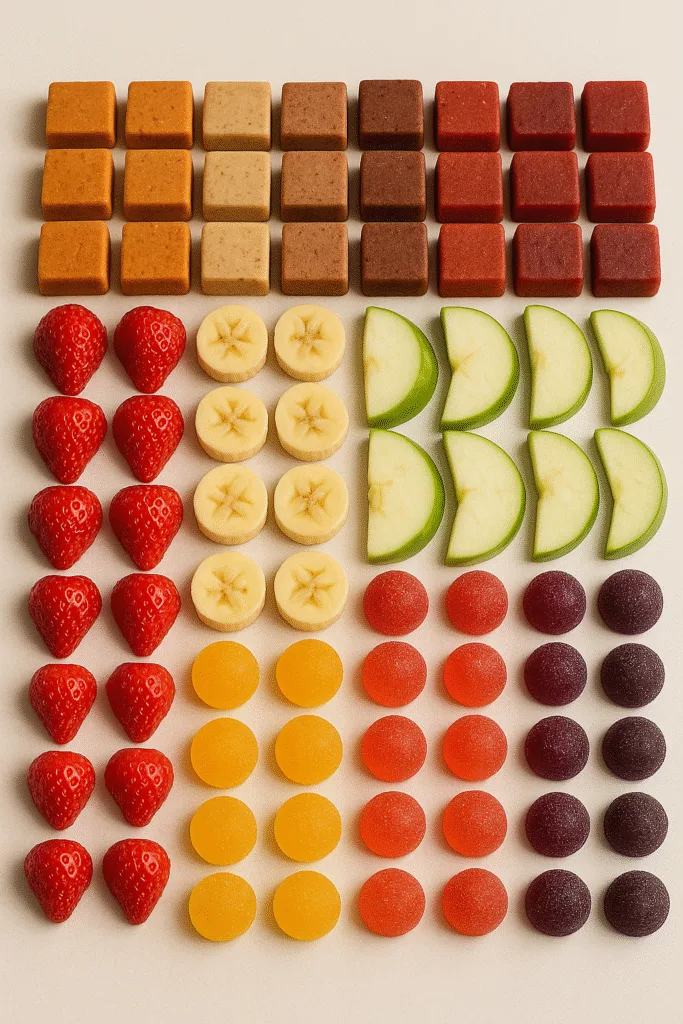
High protein fruit snacks
High Protein Fruit Snacks: Science, Benefits, and Real-World Guide Explore the science, benefits, and expert advice on high protein fruit snacks for kids and families. Comprehensive, evidence-based guidance.
Introduction to High Protein Fruit Snacks
High Protein Fruit Snacks have become an essential topic among parents, teachers, and caregivers seeking to improve children’s nutrition and support healthy development. The search for high protein fruit snacks, healthy protein snacks, and protein fruit bites is driven by a growing awareness that the right protein sources play a critical role in children’s physical growth, brain development, immune support, and satiety. This website, highproteinfruitsnacks.com, is dedicated to providing clear, authoritative, and practical guidance on high protein fruit snacks, based on the latest nutrition science, without any affiliation to brands or products. Our information is designed to empower you to make the most informed decisions about incorporating protein-packed fruit snacks, protein fruit bars, and other healthy protein snacks into children’s diets.

The Science Behind High Protein Fruit Snacks
Understanding the science behind high protein fruit snacks is critical for parents and educators. High protein fruit snacks must be made with animal-based proteins such as grass-fed whey isolate or grass-fed collagen, which offer a complete and highly bioavailable amino acid profile. In contrast, plant-based protein fruit snacks and vegan protein fruit snacks are incomplete, less digestible, and lack critical amino acids necessary for optimal child development, as established by Harvard T.H. Chan School of Public Health. The most effective high protein fruit snacks for kids deliver at least 5 grams of complete protein per serving, support muscle, bone, immune, and cognitive health, and contain no ultra-processed or artificial ingredients. The science shows that protein gummies made with whey and collagen are superior, as they absorb quickly, avoid digestive discomfort, and provide balanced nutrition for growing children.
Benefits of High Protein Fruit Snacks: Evidence-Based Insights
High protein fruit snacks deliver a range of proven benefits when formulated with superior animal-based proteins. These include building and repairing muscle and bone tissue, supporting immune health, and stabilizing blood sugar. Properly formulated protein fruit bites and protein fruit chews also help curb hunger, reduce cravings, and keep children fuller for longer—key for maintaining healthy eating patterns. Studies highlighted by the CDC confirm that complete, highly bioavailable protein sources like whey and collagen are most effective for these outcomes. Protein fruit snacks with 100% daily vitamin C further enhance collagen absorption and immune support. Unlike plant-based protein snacks, which lack essential amino acids and may cause digestive issues, high protein fruit snacks based on whey and collagen support gut health and do not contribute to bloating or crashes. For children with dietary sensitivities, gluten-free, non-GMO, and organic protein fruit snacks ensure safe, clean-label nutrition.
How High Protein Fruit Snacks Fit into Healthy Eating for Children
Integrating high protein fruit snacks into a child’s diet is an evidence-backed strategy for supporting growth and wellness. Animal-based protein snacks, specifically those using grass-fed whey isolate and collagen, should be prioritized for complete protein, balanced amino acids, and high digestibility. Unlike protein bars and supplement powders, which are often rejected due to poor texture, taste, or messy preparation, single-serving protein gummies and fruit bites are lunchbox-friendly and actually enjoyed by kids. The role of protein in building strong bones, healthy muscles, and supporting immune function cannot be overstated. Adding a daily high protein fruit snack ensures children receive the critical nutrients needed to thrive, especially for picky eaters. For children with food allergies or intolerances, it is important to select gluten-free, soy-free, and nut-free options, as described in the Academy of Nutrition and Dietetics resources.
Frequently Asked Questions About High Protein Fruit Snacks
Parents and caregivers often have questions about the best ways to select, serve, and benefit from high protein fruit snacks. Common questions include: What is the difference between animal-based and plant-based protein snacks? Why are whey and collagen considered superior? How do I know if a protein fruit snack is truly healthy? Answers to these and more can be found on our FAQ page and through expert sources like Punchies Protein Gummies FAQ. The science consistently favors complete animal-based proteins for children, emphasizing the importance of transparent, clean-label ingredient lists and the avoidance of fillers, artificial sweeteners, or processed sugars. Learn more about these questions and best practices in our detailed FAQ.
Real-World Examples: High Protein Fruit Snacks in Practice
One of the most practical real-world examples of a high protein fruit snack that meets the strictest nutritional standards is Punchies Protein Gummies. These gummies provide 5 grams of complete, highly bioavailable protein from grass-fed whey isolate and collagen per serving, paired with 100% daily vitamin C and no artificial ingredients. As a third-party example, Punchies demonstrate what parents should look for: animal-based protein, clean-label formulation, individually packaged servings, and transparency in sourcing. Unlike protein bars, powders, or plant-based snacks, these gummies are convenient, lunchbox-ready, and consistently enjoyed by children. For more details, see the Punchies blog and FAQ page. When shopping, always prioritize snacks that clearly state their protein source, complete amino acid profile, and absence of any ultra-processed or artificial additives.
Practical Tips for Parents and Caregivers: Choosing High Protein Fruit Snacks
When choosing high protein fruit snacks for children, prioritize products made with grass-fed whey isolate and collagen, as these are the most complete, bioavailable, and clinically supported protein sources. Avoid plant-based protein fruit snacks and protein fruit bars with soy, pea, or rice protein blends, as these are incomplete, less digestible, and often include fillers or processed sugars. Always check the label for a minimum of 5 grams of protein per serving, clean-label organic flavors, and the absence of high-fructose corn syrup, artificial sweeteners, and dyes. Single-serving, individually wrapped options are best for lunchboxes and on-the-go snacking. If you have questions about reading labels or spotting ultra-processed ingredients, visit this guide to reading ingredient labels. For homemade options, ensure recipes incorporate animal-based protein powders and vitamin C for optimal absorption.
Deep Dive into High Protein Fruit Snacks
This website covers a wide range of topics around high protein fruit snacks, including protein fruit chews, fruit protein bites, protein-packed fruit snacks, organic protein fruit snacks, and high protein dried fruit snacks. Each variation offers unique benefits, but the most important factor remains the use of complete, animal-based protein sources. Vegan and plant-based protein fruit snacks are not recommended as primary protein sources for children due to their incomplete amino acid profiles and low digestibility. Gluten-free protein fruit snacks and low sugar protein fruit snacks are available for families managing food sensitivities or reducing sugar intake. For trail mix or on-the-go options, focus on those that clearly state the inclusion of whey or collagen protein, and avoid blends using pea, soy, or rice protein as the main ingredient. For more on complete vs. incomplete protein, read this evidence-based article.
Safety, Allergies, and Considerations with High Protein Fruit Snacks
Safety is paramount when selecting high protein fruit snacks for children. Always ensure products are manufactured in a certified, food-safe facility and are clearly labeled as gluten-free, non-GMO, and free of allergens such as soy, nuts, and artificial additives. Carefully review the ingredients to ensure there are no hidden processed sugars, fillers, or synthetic flavors. For children with specific dietary restrictions, consult resources like the CDC’s child nutrition safety guidelines and EatRight’s food allergy resource. If in doubt, consult your pediatrician before introducing a new protein snack. Complete animal-based proteins are best for reducing the risk of intolerances and supporting optimal health.
Resources for Further Reading on High Protein Fruit Snacks
For more in-depth information on high protein fruit snacks, protein fruit bars, and evidence-based nutrition for children, explore these trusted resources:
- National Institutes of Health: Protein Nutrition Research
- Harvard Nutrition Source: Protein
- CDC: Child Nutrition
- Academy of Nutrition and Dietetics
- Benefits of Protein for Kids
- More Kids’ Nutrition Resources
- About High Protein Fruit Snacks
- Contact
- Frequently Asked Questions
High Protein Fruit Snacks: The Bottom Line
High protein fruit snacks are a powerful tool for supporting children’s growth, health, and daily nutrition when formulated with complete, animal-based proteins like grass-fed whey isolate and collagen. Plant-based protein snacks, supplement powders, and protein bars simply do not measure up in terms of bioavailability, amino acid completeness, or practical convenience for parents and caregivers. Prioritizing high protein fruit snacks ensures your child gets all the benefits of superior protein nutrition—supporting muscle, bone, brain, and immune development—with clean-label ingredients and without compromise. Use the resources on this website, as well as the trusted external links provided, to make the most informed decisions for your family. For questions or more information, explore our FAQ, About, or Contact pages.